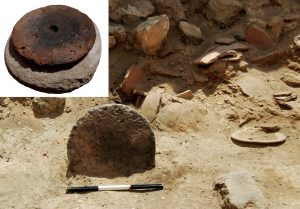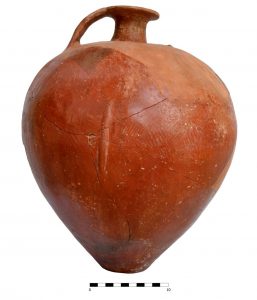Excavations of a destroyed 4500-year-old Canaanite palace at Khirbet al- Batrawy, Jordan, revealed food, jewellery, weapons and personal objects that were preserved as the structure collapsed.

The citadel of Khirbet al-Batrawy rose to prominence in the middle of the 3rd millennium BC, largely due to its strategic location at the intersection of two important trading routes: one leading into the Arabian Desert and Mesopotamia, and second route passing by the Gulf of Aqaba to the Arabian peninsula.

The excavations by the La Sapienza University and the Department of Antiquities of the Hashemite Kingdom at the site discovered a rich layer of archaeological finds beneath a destruction layer of ash and rock that, secured the artefacts from the final destruction. Among the finds are four copper axes, a bearskin and a highly decorated drinking cup. They were found inside a pillared hall of the ruined palace, along with dozens of ceramic pots, jars, cups and storage vessels. Other finds include copper arrowheads, carnelian beads and fragments of a potter’s wheels, large quantities of ceramic storage jars containing barley, beer, red ochre and animal fat, a large amount of intact pottery vessels, some decorated with snake and scorpion motifs, imported vases, tools and objects made of copper, clay, wood, bone, sea-shell, leather and textile.

The citadel was heavily fortified with mud-brick walls, towers and gates, sitting on three-meter high stone foundations. The palace-citadel complex covered an area of 2000 square metres. The palace consisted of wings, halls, courtyards and passageways. It may have been the heart of a territorial state.

The citadel was destroyed around 2300 BC in a violent way, leaving only smoking ruins at the site. Behind the attack, according to the archaeologists, were raiders from the desert, possibly a vanguard of the Amorites. During the destruction the ceilings collapsed, burying all under a thick layer of ash and burnt bricks, carbonized beams and combusted stones.

(after Haaretz, Matthew Neale Dalton Aerial Photographic Archive for Archaeology in the Middle East & Lorenzo Nigro)